

Converting Green-Screens
This section will guide you through the process of converting Green-Screen applications to a browser interface.
RPGsp’s
Green Screen to Web conversion tool uses unique Dream Architecture technology to
convert RPG+DDS or CL+DDS applications to true ILE RPG-CGI Web applications. The
end result is a fully functional and customizable Web application.
Using
RPGsp’s Green-Screen to Web conversion process, it takes only minutes to go
from this:
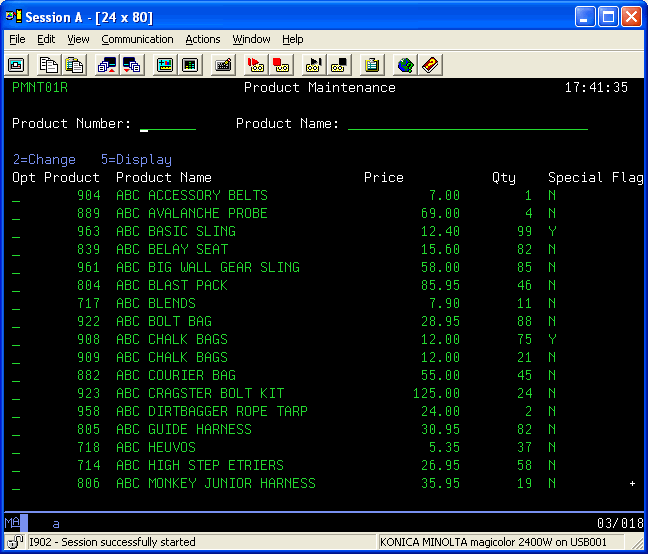
To
this:
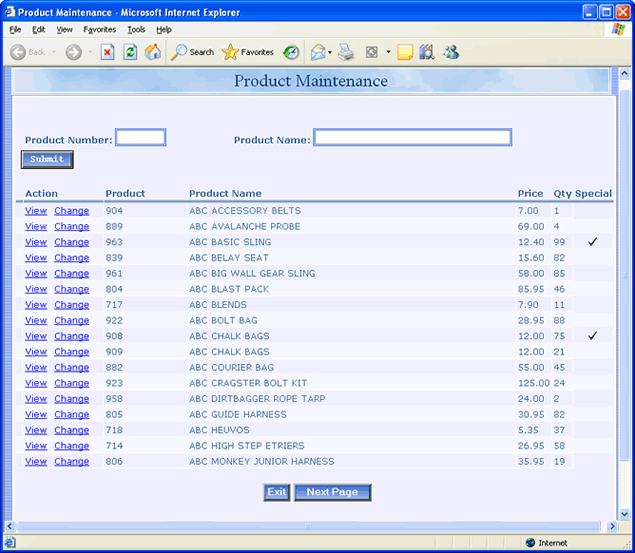
What
is the Dream Architecture?
The
Dream Architecture is RPGsp’s unique method of simulating the traditional iSeries
Green-Screen programming environment, including the program call stack, display files
with multiple record formats, inherent record-locking, subfiles with updatable fields,
and program parameters. It is especially well suited for converting Green-Screen
programs to the Web.
Using
the Dream Architecture, RPGsp’s Green-Screen to Web conversion process does
not employ Web-Facing or Screen-Scraping technologies, but actually restructures
the portions of code that deal with display files so that it will interact with HTML
code instead. Only code that deals with display file processing is modified, leaving
the original business logic intact.
What
are the Advantages?
The advantage of using RPGsp’s Green-Screen to Web conversion process over Web-Facing or Screen-Scraping methods is that the converted application is not tied to the original display file. RPGsp creates independent HTML code for the screens. Since the converted application does not depend on reading the 5250 data stream, it is not limited to what can be done on a Green-Screen. The converted application can be modified and expanded in any way. Some typical enhancements include:
Converted RPGsp applications also have the capability of running either in a browser or in a Green-Screen from one object. This allows you to maintain one set of source code for both Green-Screen and Web applications.
Since
the converted program is a true ILE RPG-CGI Web application, it will perform much
faster than a Web-Faced application.
Which
Programs Need to Be Converted?
Any
program in your application that uses a display file needs to be converted. Programs
that do not use display files, but call programs that do, also need to be converted.
The tool can convert either RPG or CL code. Programs that do not use display files
or call display file programs do not need to be converted. They can continue to be
called in their original form.
When
converting multi-program applications, make sure to also convert any called programs
(where necessary) before launching the application.
RPGsp’s
automated
mass conversion tool can analyze your source code to determine
which programs need to be converted.
Before beginning a conversion project, you should take a few moments to set up the Green-Screen to Web options.
To
begin the conversion, choose the Green-Screen to Web conversion wizard from the Wizards
menu.
Retrieving Source and Field Definitions
The
first step in the Green Screen to Web Conversion Wizard is to retrieve the DDS source
and display file field definitions. To do this, you must first specify the display
file source member and the display file object, and then click on the blue button
labeled "Retrieve Source and Field Definitions".
If
you are converting a program that does not use a display file, but calls another
program that does, enter *NONE for both the DDS Source member and the Display File
Object.
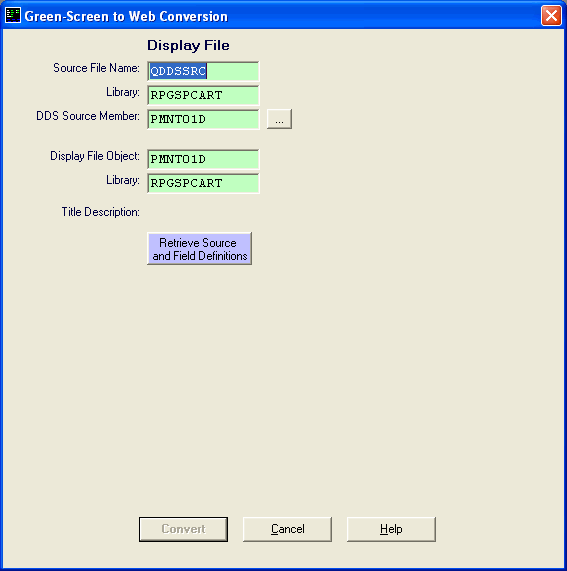
Source
File Name/Library
Type
in the File Name and Library Name of the file that contains the DDS source member.
The default file name is QDDSSRC. *LIBL is not acceptable for library name in this
wizard.
DDS
Source Member
Type
in the source member name for the display file. You can also click on the button
next to the DDS member field to browse for the member. This will most likely be the
same as the Display File name. If you are converting a program that does not use
a display file, but calls another program that does, enter *NONE here.
Display
File Object / Library
Type
in the Object Name and Library Name of the Display File Object. By default, the display
file object will be filled in with the same name as the DDS source member, and the
library name will be the same as the source file library name. *LIBL is not acceptable
for library name in this wizard. If you are converting a program that does not use
a display file, but calls another program that does, enter *NONE here.
The
Green-Screen to Web conversion process requires that RPG source code is in the ILE
format. Older code that is not in the ILE format can first be converted to ILE by
using IBM’s CVTRPGSRC (Convert RPG Source) utility that is available at no charge
as part of OS/400 (i5/OS).
RPGsp’s
automated
mass conversion tool
makes use of CVTRPGSRC in batch mode to convert multiple programs, or even entire
libraries.
After
retrieving the source and field definitions,
select Convert All Formats and Import RPG. After selecting any options you wish to
set, click the "Convert" button to begin the conversion.

Layout
Type
Layout
determines how the fields and constants are organized (or positioned) on a page.
Table
layout uses an HTML Table along with its rows and cells to position elements on a
page, while Absolute layout uses pixel-based coordinates to position elements on
a page.
Absolute
elements are removed from the normal HTML flow and positioned using style sheet attributes.
The position of an absolute element is specified in pixels from the top and left
sides of the document.
In
contrast to standard elements, absolute elements can be placed anywhere on the page
by simply dragging and dropping them with your mouse. Normal elements, on the other
hand, must follow the rules of top-to-bottom html flow, and therefore use HTML tables
for positioning.
Use
iCopy
When
this option is selected, wizard generated code that handles display files will be
placed in
iCopy
segments.
Using this option overrides the global setting for iCopy in the Green-Screen
to Web Options.
Show
All Subfile Records at Once
By
default, RPGsp will generate code to handle the paging of load-all subfiles.
When
this option is selected, the converted application will display all records in the
subfile in the browser at one time. The user will have a scrollbar to navigate through
the subfile.
Using
this option will override the global setting in the Green-Screen
to Web Options.
Theme
To select a theme for your application, click the browse button. A theme is an HTML template used by the conversion process. RPGsp includes many prebuilt themes.
Before beginning a large conversion project, you may consider creating a theme of your own to match your company's branding and colors. The conversion process looks for the "greenscreen.html" template file in a theme folder. If "greenscreen.html" is not present, "add.html" is used. Your theme may link to a CSS file which should include CSS class names that match Green-Screen attributes. For example, RI is the reverse image class, UL is underline, and BLU is the color blue. CSS files for existing RPGsp themes include a list of all applicable class names.
Inactivity
Timeout
In
this field, you can specify the time (in minutes), before your converted program
will end due to user inactivity.
During
the Conversion
Called
Programs
During
the conversion, RPGsp will attempt to determine if programs called by the converted
program use display files. RPGsp needs to add code to these program calls to handle
the displaying of HTML screens.
If
RPGsp is unable to make this determination, it will prompt you for input.
In
this example, the conversion process wants to know if the specified program call
is to a display file program.
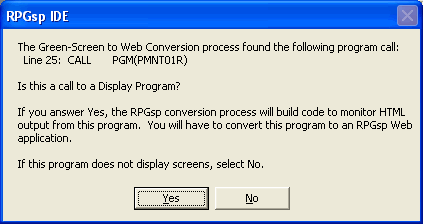
These
checks can be disabled by enabling the Silent Conversion option in the global Green-Screen
to Web options.
When this option is enabled, RPGsp will assume that all calls are to display file
programs.
Entry
Parameters
When
RPGsp converts a program that uses *ENTRY parameters, it will display the following
notification:

This
is a normal informational notification that lets you know that the calling program
needs to be converted, or that the *ENTRY parameters need to be removed from the
current program.
Compiling and Saving the Converted RPG Program
After the program is converted, you can compile it by selecting Build/Run->Compile from the menus, or by clicking the gears icon on the toolbar.
The RPGsp source for converted RPG programs is not saved automatically. You can save the program to either the local PC, IFS, or a source file named QRPGSPSRC by selecting File->Save As from the menus.
Launching
the Converted RPG Program
If
your converted RPG program does not take *ENTRY parameters, it can be launched directly.
Before launching the program, make sure that any called programs that use display
files have also been converted.
To
launch the converted application, select Build/Run->Launch
in Browser from the menus.
The
Green-Screen to Web conversion process is also capable of converting CL programs.
This includes CL programs that use display files, and also CL programs that call
other interactive programs.
To
begin the conversion, follow the steps for retrieving
the source and field definitions.
When this is complete, select "Convert All Formats and Import CL", and
select any options that you would like to set. Then, click the "Convert"
button to finish the wizard.
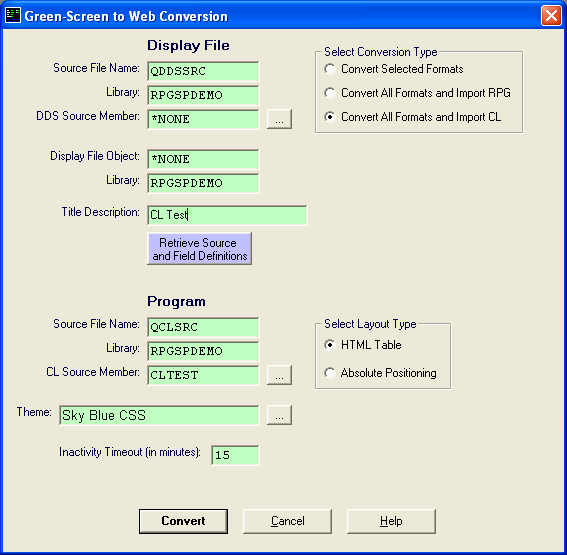
Layout
Type
Layout
determines how the fields and constants are organized (or positioned) on a page.
Table
layout uses an HTML Table along with its rows and cells to position elements on a
page, while Absolute layout uses pixel-based coordinates to position elements on
a page.
Absolute
elements are removed from the normal HTML flow and positioned using style sheet attributes.
The position of an absolute element is specified in pixels from the top and left
sides of the document.
In
contrast to standard elements, absolute elements can be placed anywhere on the page
by simply dragging and dropping them with your mouse. Normal elements, on the other
hand, must follow the rules of top-to-bottom html flow, and therefore use HTML tables
for positioning.
Theme
To select a theme for your application, click the browse button. A theme is an HTML template used by the conversion process. RPGsp includes many prebuilt themes.
Before beginning a large conversion project, you may consider creating a theme of your own to match your company's branding and colors. The conversion process looks for the "greenscreen.html" template file in a theme folder. If "greenscreen.html" is not present, "add.html" is used. Your theme may link to a CSS file which should include CSS class names that match Green-Screen attributes. For example, RI is the reverse image class, UL is underline, and BLU is the color blue. CSS files for existing RPGsp themes include a list of all applicable class names.
Inactivity Timeout
In this field, you can specify the time (in minutes), before your converted program will end due to user inactivity.
After the Conversion
The
CL conversion process generates two files:
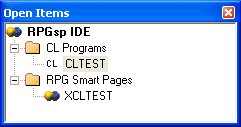
The
generated CL program is a converted version of your code that should be saved in
a source file and compiled. The most common place to save this source is in your
CGI library (RPGSP, by default). A QCLSRC file should already exist in this library.
The
generated RPG Smart Page is used to perform Web operations for the CL program, such
as outputting HTML screens, reading HTML form input, and keeping track of state.
This page should also be compiled. The page is not saved automatically
Launching
a Converted CL Program
CL programs cannot be launched directly in the browser. For this reason, you will need to create a starter program. A starter program is a simple RPGsp program that will call your converted CL program.
There
are two methods for creating a starter program. RPGsp provides a starter program
template in the samples folder. There is also a starter program code snippet that
can be used.
Using the Starter.rpgsp Program
The quickest way to create a starter program is to use the sample program provided in the RPGsp samples folder on the local PC. To open the sample program, select File->Open Local File. On the local PC, navigate to:
C:\Program Files\RPGsp\samples\STARTER.rpgsp
The starter program accepts a query string parameter named InitPgm. You can pass in the name of your converted CL program using this parameter. In this example, the starter program will be launched to call a CL program named MYCLPGM:
http://TestSystem:450/rpgsp/STARTER.pgm?InitPgm=MYCLPGM
The Build/Run->Launch in Browser option will automatically launch the starter program with the appropriate InitPgm parameter, when performed on a converted CL program.
If the InitPgm parameter is not passed to the starter program, it will attempt to retrieve the current user's initial program from the iSeries user profile. If present, the initial program will be called.
Using the Starter Program Snippet
To
create a starter program using the snippet, open a blank RPG Smart page by selecting
File->New->RPG Smart Page
from the menus. Then, switch to Code View. Next, select "Starter Page"
under the Green-Screen to Web category in the Snippets
window.
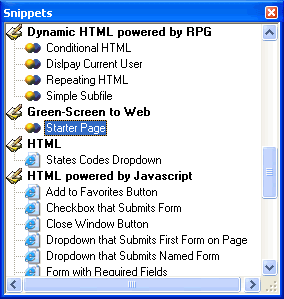
The
snippet will prompt you for the name of the program to call. Enter the name of your
converted CL program.
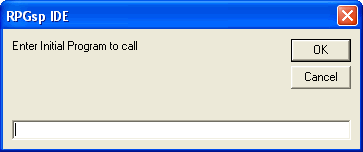
It
is also possible to convert just the DDS code for display files to HTML. This option
is useful when you would like to reuse the present layout of your screens, but do
not wish to convert the RPG or CL program logic.
In
addition to converting the DDS to HTML, RPG code is added to the screen to process
any input fields and to display output fields. This will give you a good head start
on redesigning the program logic.
To
convert just DDS screens to HTML, first retrieve
the source and field definitions
for your display file.
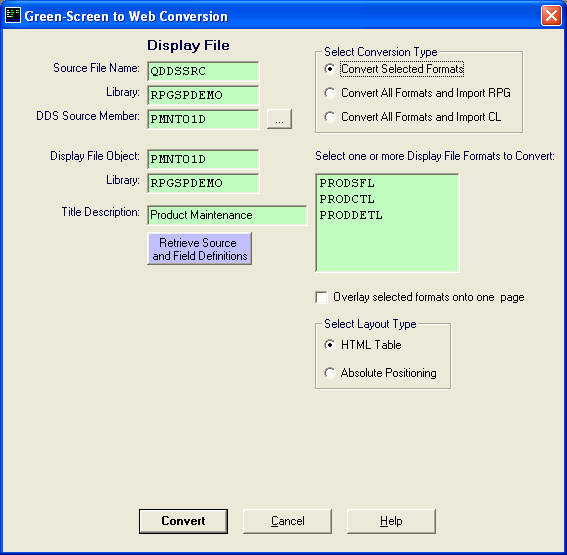
Select
the radio button labeled "Convert Selected Formats". A listing of all record
formats in the display file will appear in the list box. You can then select the
record formats you would like to convert to HTML.
Overlay
Checkbox
When
this option is checked, RPGsp will combine all selected
record formats into one HTML page, or screen. When unchecked, RPGsp will generate
one HTML page for each selected record format.
Layout
Type
Layout
determines how the fields and constants are organized (or positioned) on a page.
Table
layout uses an HTML Table along with its rows and cells to position elements on a
page, while Absolute layout uses pixel-based coordinates to position elements on
a page.
Absolute
elements are removed from the normal HTML flow and positioned using style sheet attributes.
The position of an absolute element is specified in pixels from the top and left
sides of the document.
In
contrast to standard elements, absolute elements can be placed anywhere on the page
by simply dragging and dropping them with your mouse. Normal elements, on the other
hand, must follow the rules of top-to-bottom html flow, and therefore use HTML tables
for positioning.
While
Absolute layout makes it easier to position elements in Design View, the HTML code
tends to be more organized with a Table layout, which is important when it comes
to coding the RPG logic around the HTML. Subfiles typically use Table layout.
RPGsp's Mass Conversion tool allows you to convert entire application systems and libraries to the Web in an automated process. The Mass Conversion tool has a component that runs on the iSeries to examine your source files and determine which programs use display files. It will also analyze the code to determine if a program makes calls to display file programs.
When the analysis is complete, the mass conversion process will produce a listing of programs that need to be converted, and a temporary copy of their source code. These files can then be imported into RPGsp for an automated conversion.
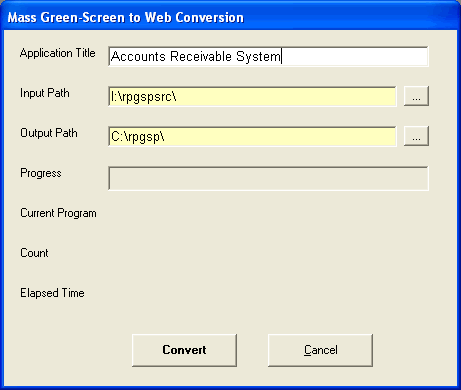
For more information on the Mass Conversion tool, please contact Profound Logic support.
Profound
Logic Software, Inc.
http://www.profoundlogic.com/
(937) 439-7925